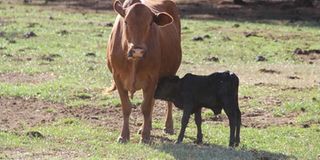AI, what every farmer needs to know and practice

A Borana cow with its crossbreed calf at Lewa Farm in Eldoret. Artificial insemination helps farmers to have the best crossbreeds for higher productivity. PHOTO | JARED NYATAYA | FILE
What you need to know:
- AI is one of the most-effective tools to improve productivity and profitability of a farmer’s cattle rearing enterprise
- There are several advantages in the utilisation of AI technologies
Artificial Insemination (AI) is a commonly used practice in animal breeding. This reproductive technology has slowly gained root in many developing countries and governments as well as private companies.
A good number of them are focused on preserving semen collected from various exotic and indigenous beef and dairy cattle breeds.
AI is one of the most-effective tools to improve productivity and profitability of a farmer’s cattle rearing enterprise. The expansion in the use of this technique is evident as local farmers are now seeking the services of AI technicians to improve their herds’ productivity.
There are several advantages in the utilisation of AI technologies:
High genetic merit
The semen often distributed by national genetic resource centres/banks or private companies is harvested from bulls of high genetic merit known from well-kept pedigree records.
In addition, the performance records of the bulls’ offspring are well-documented, giving farmers the opportunity to select semen from superior genetic animal.
Increases herd productivity
Through the use of AI by farmers, crossbreeding activities can be undertaken to improve the herd’s productivity. In crossbreeding, the key goal should be to achieve a good hybrid, whose performance is often superior to both parents.
Improvement or upgrading of local indigenous breeds can be done effectively through the use of well-planned and supervised AI activities.
Sexing of semen
With the advancement in the AI technology, female and male semen can now be sorted and concentrations of either ‘X’ or ‘Y’ semen increased by approximately 90 per cent. This gives the farmer the opportunity to choose the calf’s desired sex.
This novel technique enables farmers to also influence the sex of their herd and may result in the steady increase of heifer/bull numbers. However, sexed semen is relatively expensive as compared to conventional semen.
Disease prevention
Use of AI services by farmers is beneficial as it reduces the risk of contracting venereal diseases. These diseases can result in sterility and abortions.
Shorter calving periods
This can be achieved when AI is combined with manipulation of the estrous cycle. The synchronisation of heat can be achieved through the use of various hormonal treatments.
Increases genetic variability
Farmers can select semen from different sires at renowned semen distribution centres to serve their cows. This increases the genetic variability of their herd as opposed to having one superior bull to serve the entire herd.
Improves record keeping
Utilisation of AI prompts farmers to keep sound herd records. This includes breeding records of heat detection dates, AI service administration and calving dates.
Artificial Insemination drawbacks
The greatest challenges with AI are, first, poor heat detection resulting in low impregnation success rates and second, lack of well-trained technical personnel.
To improve pregnancy success rates, farmers should invest in excellent AI and heat synchronisation techniques that should be used simultaneously.
Often, the low conception rates experienced by smallholder farmers can be attributed to inaccurate heat detection. It is also of great importance that emphasis is placed on the training of the AI technicians. AI is a technical procedure and requires skilled personnel to increase the conception success rates.
Dr Muchunguh is a livestock expert.




